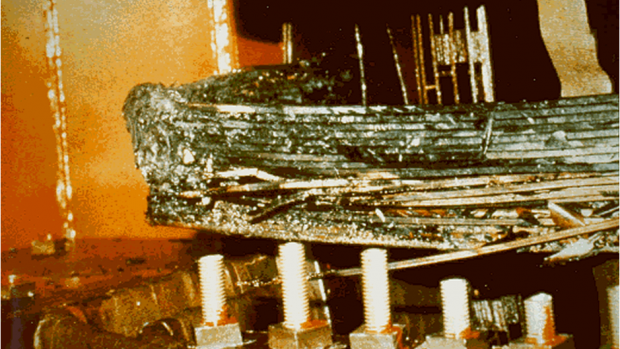
The electric power grid, and consequently the power to your home and business, can be disrupted by space weather. One of the great discoveries of the 19th century was the realization that a time-varying magnetic field is able to produce an electrical current in a conducting wire. The basic idea is that the time rate of change of the magnetic flux (i.e. lines of magnetic force) passing through a current loop is proportional to the current that is generated around the loop. A slightly earlier but equally important discovery was that a current-carrying wire produces a magnetic field. The application of these principles is widely prevalent in modern society in electrical power generators, electrical power transformers, and electrical motors, for example.
Time-varying magnetic fields and electrical current systems are not just artificial phenomena, but in fact are quite common in nature too. Natural electrical current systems which vary in time can be found inside the Earth, in the oceans, and in the upper atmosphere of the earth (above ~100 km) where the constituents of the atmosphere include positively charged ions and negatively charged electrons which move about in a myriad of complicated ways. Many of these upper atmospheric current systems are constantly present and modulate in a regular way in response to the rotation of the earth, the gravitational pull of the moon, and the slow variation of solar radiation over the course of the solar cycle. At times, though, these current systems can be greatly enhanced and exhibit rapid changes with time and space, a phenomenon typically referred to as a geomagnetic storm. Geomagnetic storms in turn are caused by disturbances that propagate away from the Sun, travel through interplanetary space and interact with Earth’s space environment.
We might expect that the early inventors of the telegraph systems did not realize that the electrical circuit they were constructing was threaded by lines of naturally produced magnetic flux, and, even more surprising, that this flux could vary with time and induce a natural current in their system. It was not too long after their deployment, though, that reports of anomalous currents were observed which could at times prohibit communication or could enable a system to be run without an electrical power source, or in more dramatic instances cause the recording paper to catch fire (see review by Boteler 2003 and references therein). Similar effects continued to be noticed from time to time with the next generation of communication lines (coaxial cables).
Another system of artificial electrical circuits began to grow with the advent of electrical power systems. Just like the telegraphs, this complicated collection of circuits is threaded by naturally produced magnetic flux and just like the telegraphs, rapid variations of this magnetic flux during geomagnetic storms causes a naturally produced current to flow through the system. This effect was first reported after the 24 March 1940 geomagnetic storm (Davidson, 1940; see also Germaine, 1940 for reports of effects on long-line communication cables). Numerous large and moderate impacts to the grid have been reported over the years, including a power blackout in 1958 (Lanzerotti & Gregori, 1986), equipment tripping and voltage stability issues (4 August 1972), a nine-hour blackout in Canada and a transformer loss (13 March 1989 - see photo), and a blackout in Sweden during the October 2003 storm. (See Boteler, 2001, for a comprehensive compilation of effects).
Assessing the impact of geomagnetic storms on the electrical power grid involves a number of considerations. The path for current flow that responds to the varying external currents in the upper atmosphere follows artificial current paths on the ground (the power lines) as well as various natural current paths (e.g. conducting structures below the ground and nearby bodies of water). Once the natural current paths are accounted for, the net geoelectric field that is imposed on the artificial current paths results in a quasi D.C. (periods of 10 seconds to 10’s (tens) of minutes) current in the power lines. These geomagnetically induced currents cause the ‘exciting current’ in power transformers to operate out of their designed range, resulting in saturation of the magnetic core material inside the transformer. Once the core saturates, the transformer no longer provides any back ‘electromotive force’ (a kind of electrical inertia) and the currents and voltages in the windings become abnormally large. Depending on the transformer design, this can lead to heating of the surrounding structures due to induced ‘Eddy Currents’ which has the potential to damage parts of the transformer. An additional impact of transformer saturation is that the voltages and currents no longer have a simple sinusoidal (60 cycle) form and this can cause protective equipment elsewhere in the grid to trip when it shouldn’t. These equipment ‘trips’ can take needed equipment off line and cause voltage stability problems. An additional issue for the system is that all of the transformers that are saturating show up as a significant inductive load on the grid as a whole. This means that a system that is near peak levels of demand prior to the geomagnetic storm event may not be able to meet the total power demand when the geomagnetic storm occurs, leading to partial or system wide blackouts.
References
Boteler, D.H., Geomagnetic Hazards to Conducting Networks, Natural Hazards, 28: 537-561, 2003
Boteler, D.H, Geomagnetic Hazards, Geological Survey of Canada, Bulletin 548, 2001
Davidson, W.F., The magnetic storm of March 24, 1940 – effects in the power system, Edison Electric Institute Bulletin, 1940
Germaine, L.W., The magnetic storm of March 24, 1940 – effects in the communication system, Edison Electric Institute Bulletin, 1940
Lanzerotti, L.J. and G.P. Gregori, Telluric currents: the natural environment and interactions with man-made systems; in The Earth’s Electrical Environment, (ed) R. Roble and E.P. Krider; National Academy Press, Washington D.C., pp 232-257, 1986